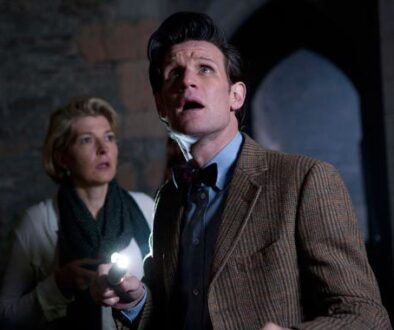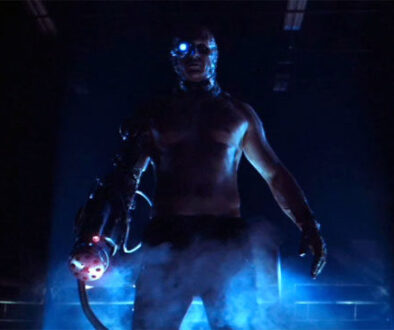A Town Called Mercy Review

Clint Hassell gives his verdict on the third episode of Series 7.
Toby Whithouse has written three of my favorite Who-related episodes, including Series 2’s “School Reunion,” Torchwood’s “Greeks Bearing Gifts,” and last series’ “The God Complex.” I appreciate that Whithouse’s stories usually relegate their fantastic settings and plot elements to the background, in order to focus on developing characters with depth – a key element in truly great science fiction. Whithouse’s scripts begin to falter when a gimmicky location and/or time period is pushed front and center, as evidenced by his Series 5 episode, “The Vampires of Venice.”
Unfortunately, the locale of “A Town Called Mercy” apparently forced Whithouse to include all of the tropes from every Western film into one 45-minute episode:
- Townspeople stare silently in fear, as an unfamiliar visitor strolls into town.
- The Lord’s Prayer is slowly recited.
- The hero rides a horse across the dusty plains.
- Scared villagers form a lynch mob.
- A gunfight occurs at noon, the scorching sun overhead, the shot of the clock tower coming into focus over the hero’s shoulder.
Heck, so many films get referenced that scenes are even copied from Western comedies and parodies:
- “Tea. The strong stuff. Leave the bag in.”
- Lack of experience leads to a gun being fired, accidentally (which is ironic considering one of Amy’s defining moments as a companion is shooting a little girl in the face).

To Whithouse’s credit, all of the aforementioned events fit seamlessly into the narrative and therefore stop just short of becoming clichés; however, every plot point feels expected. Marshal Isaac’s death, the Doctor becoming the new marshal, Kahler-Jex’s sacrifice, the Gunslinger becoming the new marshal – there was little surprise to anything that happened within the hour.
It doesn’t help that “A Town Called Mercy” shamelessly borrows elements from recent episodes:
- The opening narration seems to reference the Doctor, but doesn’t (“A Good Man Goes to War”).
- To the Doctor, we’re the aliens (“Meanwhile in the TARDIS”).
- The Doctor speaks “horse” (“The Lodger,” “Closing Time”).
- Amy urges the Doctor to find another way, once he has made the decision to kill (“The Beast Below”).
I probably wouldn’t mind all of the homages, except that they leave little room for character development in the script. Truly, only the Doctor and Kahler-Jex are anything more than one-dimensional characters. Marshal Isaac dies before showing anything other than blind adoration for Jex, and even Amy and Rory are reduced to stock companion roles. Within the first third of the episode, Rory literally becomes cannon fodder, while Amy is held hostage. The two then fulfill the standard companion function of voicing, for the audience’s benefit, the arguments for and against punishing Kahler-Jex. Rory then serves as cannon fodder, again, while Amy practically disappears from the third act of the episode. “A Town Called Mercy” only reinforces that the Ponds were meant to leave at the end of Series 6, and that their extended stay is only due to the necessary delay of introducing a new companion in the latter half of Series 7.

Perhaps, if Whithouse had focused less on the episode’s Western setting, he could have fixed the many plot holes in his script:
To distract the Gunslinger and allow the Doctor to investigate Kahler-Jex’s ship, Isaac dresses as Jex and runs through the desert. He is accompanied by Rory, indicating that the Doctor has deduced that the Gunslinger will not fire on Jex if it will endanger innocent civilians. This is sensible, considering the Doctor’s first experience with the Gunslinger. However, after an audible alarm attracts the Gunslinger to Jex’s ship, the Doctor admits to not understanding why the cyborg doesn’t just teleport within the town and kill his creator. Why, then, was Isaac dressed as Kahler-Jex? According to Isaac, the Gunslinger would have chased any townsperson – not just Jex, specifically – hence the reason the villagers have been trapped within the wood-and-rock circle.
At the episode’s end, how do the Gunslinger and Kahler-Jex communicate? In addition to electricity, did Jex also wire the town with microphones and speakers?
Also, several questions remain unanswered:
- What was the purpose of the hovering, alien machine destroyed by the Gunslinger in the pre-credits teaser?
- Despite only needing to take one step, Jex makes no effort to cross the wood-and-rock barrier for more than nine seconds, thus allowing the Gunslinger to target him. Why?
- If the Gunslinger was willing to execute Kahler-Jex in front of a crowd of townspeople, why doesn’t he take the opportunity to shoot Jex while the Doctor is cradling a dying Isaac, and the villagers have moved even further back?

Despite a script that is constrained by its setting, “A Town Called Mercy” isn’t unenjoyable. In fact, several moments stand out:
- The Doctor demonstrates that he is always paying attention to the tiniest of details, as he figures out that the “alien doctor,” referenced by the Gunslinger, is known and beloved by the townsfolk, and is being harbored inside the jail.
- The oblique reference to River Song.
- The Doctor’s blind trust in Amy’s character. (“Yes . . . . I don’t know . . . . Whatever Amy said.”)
- The maturity of the Doctor in considering the future victims of those to whom he shows mercy.
- The Doctor’s apparent guilt in not terminating the threat of the Daleks or the Master.
- “Is he really worth the risk?” “I don’t know, but you are.”
- The argument that Jex doesn’t get to decide “when and how [his] debt is paid.”
I love that, in the scene when the townspeople first throw the Doctor across the wood-and-rock circle, the Gunslinger appears behind the Doctor, as if a mirage on the horizon – masterfully done, considering the desert setting. (Note that there’s no real reason why the Gunslinger needs to teleport – the fact that he can actually creates a plot hole. However, as in “Dinosaurs on a Spaceship,” the narrative shortcut is used here so that the villagers don’t have to talk for 10 minutes as the Gunslinger walks from the surrounding hills to the edge of town.)
I also appreciate the episode’s examination of another species’ concept of religion. So often in Doctor Who, religion is only referenced humorously (“The End of the World”), as a basis for evil (“The Impossible Planet”/“The Satan Pit”), or the concepts are twisted to be unrecognizable as religion (“The Time of Angels”/“Flesh and Stone,” “A Good Man Goes to War”). It’s sensible to see certain religious themes as being, literally, “universal.”
Finally, I relish Amy’s observation that prolonged excursions inside the TARDIS will make it appear as if Amy and Rory are aging at an accelerated rate – a concept I’ve often contemplated, and was surprised was not directly referenced in “Aliens of London,” when Jackie and Mickey had aged a year relative to Rose.







